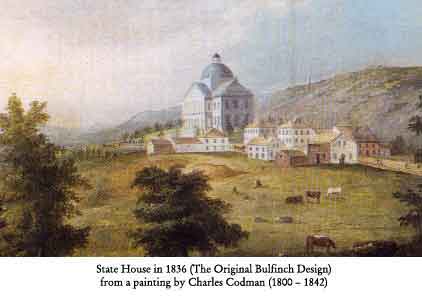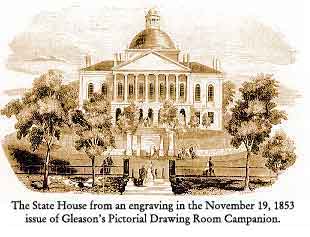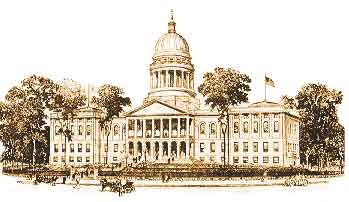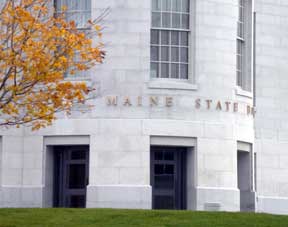A Brief History of the Maine State House
When Maine separated from Massachusetts and became a state on March 15, 1820, Portland became the temporary capitol city. The first State House was a modest two-story Federal style building at the corner of Congress and Myrtle Streets. It served as Maine's State House until 1832 and was eventually destroyed in the Great Fire of 1866.
 Though the temporary capitol of Portland was the largest city in the state many thought a permanent capitol should be more centrally located. A number of cities and towns sought the honor of becoming the state capitol and site of the new State House. The principal aspirants were Portland, Brunswick, Hallowell, Waterville, Belfast, Wiscasset and Augusta. The Legislature finally selected the City of Augusta, and Governor Enoch Lincoln signed the bill establishing Augusta as the official capitol on February 24, 1827.
Though the temporary capitol of Portland was the largest city in the state many thought a permanent capitol should be more centrally located. A number of cities and towns sought the honor of becoming the state capitol and site of the new State House. The principal aspirants were Portland, Brunswick, Hallowell, Waterville, Belfast, Wiscasset and Augusta. The Legislature finally selected the City of Augusta, and Governor Enoch Lincoln signed the bill establishing Augusta as the official capitol on February 24, 1827.
A 34 acre site for the Capitol was selected on “Weston Hill”, on the western side of the Kennebec river, by a public buildings commission which was headed by Governor William King. The piece of land was deeded to the State in 1827 by a group of patriotic Augusta owners for a sum of ten dollars. The great New England architect, Charles Bulfinch was enlisted to design plans for the new building. He had also designed the Massachusetts State House and the United States Capitol Building in Washington.
For the design of the Maine capitol Bulfinch chose the basic outline of the Massachusetts capitol building but aimed for a Greek Revival simplicity which could be executed well using local granite material. About one hundred and fifty feet in length, including the central portion with columns and cupola and two wings extending north and south, the building’s cornerstone was laid on the 4th of July, 1829, amid impressive Masonic ceremonies. Granite was hauled from Hallowell to Augusta by oxen and blocks for the second story were hauled up a runway into the building. Construction was completed in January of 1832, with a final cost of $145,000, an unheard of figure for that time. Maine boasted one the nation’s most beautiful and modern capitol buildings, although complaints ensued of a leaky roof and faulty heating system, the latter causing the building to catch fire on more than one occasion.
columns and cupola and two wings extending north and south, the building’s cornerstone was laid on the 4th of July, 1829, amid impressive Masonic ceremonies. Granite was hauled from Hallowell to Augusta by oxen and blocks for the second story were hauled up a runway into the building. Construction was completed in January of 1832, with a final cost of $145,000, an unheard of figure for that time. Maine boasted one the nation’s most beautiful and modern capitol buildings, although complaints ensued of a leaky roof and faulty heating system, the latter causing the building to catch fire on more than one occasion.
The Maine Legislature held its first session in the new State Capitol on January 4, 1832. At that time all of state government was housed in the State House. As state government grew, expansion and remodeling projects became necessary. The interior of the Capitol was remodeled in 1852 and again in 1860 to provide additional room for state departments. In 1890-1891, a large three-story wing, designed by Boston architect Calvin Spoffard, was added to the rear of the building for a cost of $150,000. The new wing would accommodate the State Library and provide more office space for departments
The city of Portland made repeated attempts over the course of eight decades to regain the honor of being Maine’s capitol, but was ultimately unsuccessful. By 1907, the debate surrounding a final attempt to move the seat of state government made clear the inadequacy of working space in the Capitol building.
 Major remodeling of the Capitol during 1909-1910 established the present-day appearance of the building. It was enlarged according to designs by G. Henri Desmond, and executed by Charles Hichborn of Augusta. This remodeling necessitated the demolition of almost all the old building save the portico and front and rear walls. The length of the building was doubled to three hundred feet by extending the north and south wings. The low saucer dome of Bulfinch's design was replaced by the current 150-foot copper-covered one and surmounted by a statue depicting the female figure of Wisdom, designed by sculptor W. Clark Noble of Gardiner. The construction and remodeling costs totaled $350,000.
Major remodeling of the Capitol during 1909-1910 established the present-day appearance of the building. It was enlarged according to designs by G. Henri Desmond, and executed by Charles Hichborn of Augusta. This remodeling necessitated the demolition of almost all the old building save the portico and front and rear walls. The length of the building was doubled to three hundred feet by extending the north and south wings. The low saucer dome of Bulfinch's design was replaced by the current 150-foot copper-covered one and surmounted by a statue depicting the female figure of Wisdom, designed by sculptor W. Clark Noble of Gardiner. The construction and remodeling costs totaled $350,000.
Construction in the 1950's of the state office building, and completion in 1971 of the Cultural Building, resulted in the removal of many of the agency offices from the State House. House and Senate chambers were refurbished in the mid-1960's, at a cost of $350,000, with new carpeting, furniture, heating , lighting, and electronic public address and voting systems. The glass partition separating lobbyists and guests from the House chamber was added at that time.
A 1967 study, by Bernard Soep Associates of Boston, found that much of the State House had lost its charm and showed the ravages of time. It recommended major redistributions of space, upgrades to electrical and plumbing systems, and renovations to part of the West wing. The State Museum and State Library moved to the new Cultural Building in 1971, although the latter's legal collection remained in the State House as part of the newly-created Maine State Law and Legislative Reference Library. The Governor and his staff moved in to the renovated West wing late in 1972. The House Chamber was repainted, re-carpeted and had falling ceiling tiles replaced in 1979.
Roof leaks had plagued the main State House and north and south wings since the original construction and renovations of 1910-1911. Except for needed repairs and general refurbishing, no major physical changes had been made to the building since 1911. As the State House reached it's 150-year mark, still dogged by grumblings of poor ventilation, cracked floor tiles, insufficient quarters, poor public access and general drabness unbefitting the state's most public building, a new movement to spruce up the Capitol building gained momentum.
A 1981 report to the Legislature by the Maine Historic Preservation Commission suggested much needed physical improvements and a consistent, dignified approach to decor throughout the building. The Senate chamber was refurbished in 1984, partly to accommodate an increase of two members following redistricting changes. In 1985 the long-restricted Senate gallery was strengthened and re-opened to the public. Utility poles around the capitol were removed and electrical wires buried in 1986. The pockmarked and peeling dome was stripped and repainted in 1988. The front steps were crumbling and deemed unsafe and closed off in 1991 until a temporary patch job was completed by an inmate crew.
In 1991 the possible presence of the building's original time capsule was discovered by a local sleuth with a metal detector. A rectangular metal object was detected embedded in the cornerstone found beside the fifth step of the original seven-step stairway to the main entrance. Considering the bleak financial picture at the time, a decision was made to let the capsule rest until a more momentous occasion or future anniversary. Though there's no way of knowing what is actually in the cornerstone, a history of Augusta says that a copy of the state Constitution, some currency of the day, publications and a special plate were placed there at the time of dedication. In 1989, in a ceremony commemorating the building's 160th anniversary, a stainless steel time capsule was buried near the front wall of the State House. It is to be opened in 2029.
In 1993 officials hired a Massachusetts firm specializing in preservation and rehabilitation of historic buildings to perform a study of the overall "health" of the Capitol building. Multiple deficiencies in the structural capacity of the building were identified, particularly in public areas where large groups of people congregated during legislative sessions.
A new phase of renovations to the long-neglected State House and it's grounds began in the mid-1990's, with the improvement of the state's economy. One of the first tasks was the complete reconstruction and renovation of the crumbling granite retaining wall and cast-iron fencing encircling the Capitol. It had not been repaired since the 1910-1911 renovations. The dome was rewired and illuminated at night once again, after being in darkness since 1987. The inside of the dome was also restored and visible from inside the State House.
By 1996 a master plan for restoring and modernizing the entire building was developed by Bath architects, Weinrich and Burt and implemented by Granger Northern in phases over a span of five years.  Changes included improved public and handicapped access, structural reinforcement, health and safety improvements, technological upgrades, and esthetic refurbishing of the building and landscaping. The dismal and leaky underground tunnel connecting the State House with the Cross Office Building was completely rebuilt to include a large skylight, the Klir Beck dioramas and a granite mural, by artist Evan Haynes, of text written in English, French, Passamaquoddy, Penobscot and Abenaki languages. The east-facing granite steps were re-set on a new foundation and a new public entrance was created in the west wing.
Changes included improved public and handicapped access, structural reinforcement, health and safety improvements, technological upgrades, and esthetic refurbishing of the building and landscaping. The dismal and leaky underground tunnel connecting the State House with the Cross Office Building was completely rebuilt to include a large skylight, the Klir Beck dioramas and a granite mural, by artist Evan Haynes, of text written in English, French, Passamaquoddy, Penobscot and Abenaki languages. The east-facing granite steps were re-set on a new foundation and a new public entrance was created in the west wing.
The weather-worn, long- oxidized copper sheathing of the dome was replaced in 2014 for the first time since 1909-1920. Gone was the long familiar green color. After the scaffolding was removed and the project completed, the dome shined like a new penny for a short time until it turned to brown. The dome will not turn green again for about 30 years. The project also included the re-gilding of the Lady of Wisdom statue on top of the dome. The entire project was completed in November 2014 and cost about $1.3 million.
![]() For More Information
For More Information ![]()
How Augusta became and stayed the state capital / Neil Rolde. [Augusta, ME : Kennebec Historical Society, 1982?
Maine's capitol / Federal Writers' Project (ME). Augusta, ME, Kennebec Journal Print Shop, 1939.
The Maine State House : a brief history and guide / Earle G. Shettleworth. Augusta, ME : Maine Historic Preservation Commission, 1981.
Report of Commission on the enlargement of the State House to the Legislature of Maine 1911 / Maine. Legislature. Commission on the Enlargement of the State House. [1911]
Report of study to determine the ideal use of space in the State House, State of Maine / Bernard Soep Associates. B. Soep Assoc.: Boston, MA,1967.
The State House and the Blaine House : a report to the state government committee of the 110th Maine Legislature [ Augusta, ME]: The Maine Historic Preservation Commission, 1981.
Capitol Building newspaper clippings in the collection of the Maine State Law and Legislative Reference Library
|
When Maine separated from Massachusetts and became a state on March 15, 1820, Portland became the temporary capitol city. The first State House was a modest two-story Federal style building at the corner of Congress and Myrtle Streets. It served as Maine's State House until 1832 and was eventually destroyed in the Great Fire of 1866.
For the design of the Maine capitol Bulfinch chose the basic outline of the Massachusetts capitol building but aimed for a Greek Revival simplicity which could be executed well using local granite material. About one hundred and fifty feet in length, including the central portion with The Maine Legislature held its first session in the new State Capitol on January 4, 1832. At that time all of state government was housed in the State House. As state government grew, expansion and remodeling projects became necessary. The interior of the Capitol was remodeled in 1852 and again in 1860 to provide additional room for state departments. In 1890-1891, a large three-story wing, designed by Boston architect Calvin Spoffard, was added to the rear of the building for a cost of $150,000. The new wing would accommodate the State Library and provide more office space for departments The city of Portland made repeated attempts over the course of eight decades to regain the honor of being Maine’s capitol, but was ultimately unsuccessful. By 1907, the debate surrounding a final attempt to move the seat of state government made clear the inadequacy of working space in the Capitol building.
Construction in the 1950's of the state office building, and completion in 1971 of the Cultural Building, resulted in the removal of many of the agency offices from the State House. House and Senate chambers were refurbished in the mid-1960's, at a cost of $350,000, with new carpeting, furniture, heating , lighting, and electronic public address and voting systems. The glass partition separating lobbyists and guests from the House chamber was added at that time. A 1967 study, by Bernard Soep Associates of Boston, found that much of the State House had lost its charm and showed the ravages of time. It recommended major redistributions of space, upgrades to electrical and plumbing systems, and renovations to part of the West wing. The State Museum and State Library moved to the new Cultural Building in 1971, although the latter's legal collection remained in the State House as part of the newly-created Maine State Law and Legislative Reference Library. The Governor and his staff moved in to the renovated West wing late in 1972. The House Chamber was repainted, re-carpeted and had falling ceiling tiles replaced in 1979. Roof leaks had plagued the main State House and north and south wings since the original construction and renovations of 1910-1911. Except for needed repairs and general refurbishing, no major physical changes had been made to the building since 1911. As the State House reached it's 150-year mark, still dogged by grumblings of poor ventilation, cracked floor tiles, insufficient quarters, poor public access and general drabness unbefitting the state's most public building, a new movement to spruce up the Capitol building gained momentum. A 1981 report to the Legislature by the Maine Historic Preservation Commission suggested much needed physical improvements and a consistent, dignified approach to decor throughout the building. The Senate chamber was refurbished in 1984, partly to accommodate an increase of two members following redistricting changes. In 1985 the long-restricted Senate gallery was strengthened and re-opened to the public. Utility poles around the capitol were removed and electrical wires buried in 1986. The pockmarked and peeling dome was stripped and repainted in 1988. The front steps were crumbling and deemed unsafe and closed off in 1991 until a temporary patch job was completed by an inmate crew. In 1991 the possible presence of the building's original time capsule was discovered by a local sleuth with a metal detector. A rectangular metal object was detected embedded in the cornerstone found beside the fifth step of the original seven-step stairway to the main entrance. Considering the bleak financial picture at the time, a decision was made to let the capsule rest until a more momentous occasion or future anniversary. Though there's no way of knowing what is actually in the cornerstone, a history of Augusta says that a copy of the state Constitution, some currency of the day, publications and a special plate were placed there at the time of dedication. In 1989, in a ceremony commemorating the building's 160th anniversary, a stainless steel time capsule was buried near the front wall of the State House. It is to be opened in 2029. In 1993 officials hired a Massachusetts firm specializing in preservation and rehabilitation of historic buildings to perform a study of the overall "health" of the Capitol building. Multiple deficiencies in the structural capacity of the building were identified, particularly in public areas where large groups of people congregated during legislative sessions. A new phase of renovations to the long-neglected State House and it's grounds began in the mid-1990's, with the improvement of the state's economy. One of the first tasks was the complete reconstruction and renovation of the crumbling granite retaining wall and cast-iron fencing encircling the Capitol. It had not been repaired since the 1910-1911 renovations. The dome was rewired and illuminated at night once again, after being in darkness since 1987. The inside of the dome was also restored and visible from inside the State House. By 1996 a master plan for restoring and modernizing the entire building was developed by Bath architects, Weinrich and Burt and implemented by Granger Northern in phases over a span of five years.
The weather-worn, long- oxidized copper sheathing of the dome was replaced in 2014 for the first time since 1909-1920. Gone was the long familiar green color. After the scaffolding was removed and the project completed, the dome shined like a new penny for a short time until it turned to brown. The dome will not turn green again for about 30 years. The project also included the re-gilding of the Lady of Wisdom statue on top of the dome. The entire project was completed in November 2014 and cost about $1.3 million.
|


